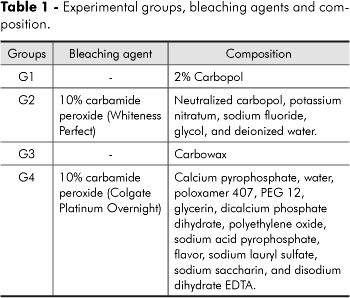Dental bleaching occurs due to an oxidation reaction between the bleaching agents and the macromolecules of pigments in the teeth. This reaction is unspecific and the peroxides can also affect the dental matrix causing mineral loss. On the other hand, recent studies have suggested that the thickener agent carbopol can also cause mineral loss. Thus, the objective of this study was to evaluate in vitro the effect of at-home dental bleaching on dental enamel microhardness after the use of bleaching agents with and without carbopol as a thickener agent. Bovine dental slabs with 3 x 3 x 3 mm were obtained, sequentially polished, and randomly divided into 4 groups according to the experimental treatment: G1: 2% carbopol; G2: 10% carbamide peroxide with carbopol; G3: carbowax; G4: 10% carbamide peroxide with poloxamer. Bleaching was performed daily for 4 weeks, immersed in artificial saliva. Enamel microhardness values were obtained before the treatment (T0) and 7 (T1), 14 (T2), 21 (T3), 28 (T4), and 42 (T5) days after the beginning of the treatment. ANOVA and Tukey's test revealed statistically significant differences only for the factor Time (F = 5.48; p < 0.01). All bleaching and thickener agents caused no alterations on the enamel microhardness.
Dental enamel; Hardness tests; Tooth bleaching; Thickeners



